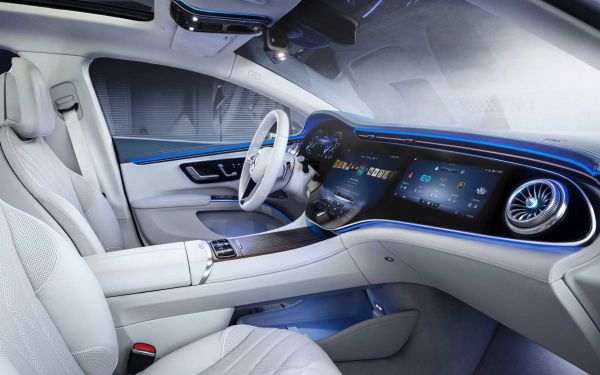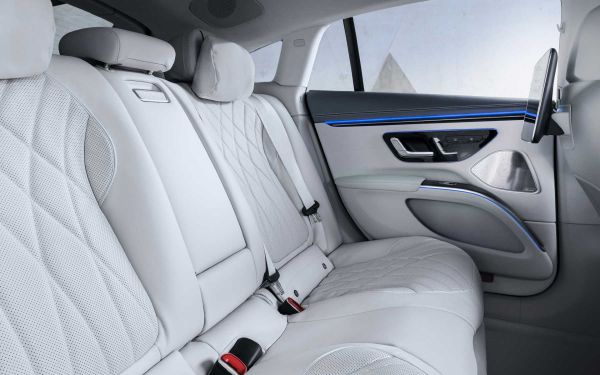Mercedes EQS: The electric revolution from Stuttgart?

With its new electric flagship, the Mercedes EQS, the Stuttgart-based carmaker not only wants to teach the Porsche Taycan and the Audi e-tron GT to fear, but also compete with Tesla. You can find out why this can succeed in the following.
"Electric First": The EQS as an exclamation mark of Mercedes' e-mobile strategy
With the EQC, EQA and EQV, Mercedes-Benz launched its first all-electric vehicles in 2019 and 2021 respectively. However, its implementation was not received positively throughout: a lack of courage and a rather half-hearted adaptation of the technologies proven in the combustion engine models was criticized by the trade press. For the "Electric First" strategy announced in October 2020, with which the company aims to achieve the goal of CO2 neutrality by 2039, the first two forays into the world of electromobility seemed to fall short for many experts.
With the EQS, the Swabians are now taking a completely different approach: Similar to Volkswagen with the Modular Electric Drive Toolkit (MEB), Mercedes-Benz is relying on a specially developed e-car platform with the typical skateboard architecture for the EQS for the first time. In this case, the battery block practically forms the vehicle floor and thus provides more stability. The engines, on the other hand, are located at the front and/or rear. The advantage: Virtually any vehicle shape can be implemented on the skateboard.
Mercedes is thus laying the foundation for its so-called Modular Electric Architecture (MEA) to put not only the EQS on the road, but also other electric car models such as the electric variant of the E-Class in the future. The MEA thus forms the blueprint for an entire Mercedes e-car fleet.
Mercedes EQS: Range of up to 770 kilometres as a declaration of war on the competition
Mercedes then also takes full advantage of the high flexibility of the new vehicle architecture with the EQS: With a length of 5.21 meters, the wheelbase is an impressive 3.21 meters. This means plenty of space for batteries for the EQS: batteries with a capacity of up to 107.8 kWh can be accommodated in the EQS. According to the manufacturer, this should enable a range of up to 770 kilometers (according to the WLTP procedure) - a value that even puts Tesla's current range champion, the Model S, in the shade. If that's not enough, you can drive up to the fast-charging station with the EQS: Thanks to 200 kW charging power, the new luxury Mercedes should be able to recharge 300 kilometers in just 15 minutes.

However, the EQS owes its long range not only to the large battery, but also to its shape. In contrast to traditionally more angular luxury cars, it is designed in the shape of a single arch. As a result, the new luxury-class Mercedes offers extremely low wind resistance. The so-called Cd value, i.e. the aerodynamics, represents the previous world record of 0.2. By comparison, the NIO ET7, which is also celebrated as particularly streamlined, has a drag coefficient of 0.23.
That's why the drag coefficient is so important for e-cars
Air resistance is so crucial in vehicle construction – and especially in electric cars – because the associated drag coefficient has a major influence on consumption and thus on range. To illustrate: Even at a speed of 100 km/h, air resistance represents the greatest driving resistance – and it grows exponentially with the square of the speed. If we look at the power required to overcome drag, the importance of the drag coefficient becomes even clearer: Due to the fact that speed must also be taken into account (power requirement = force x speed), doubling the speed means an eightfold increase in the power required.
The site spare-benzin.de has calculated a concrete example: At a speed of 100 km/h, a Golf 7 needs 7.6 kW to overcome air resistance. At a speed of 200 km/h, on the other hand, it is already 61 kW. If this speed is maintained over the period of one hour, consumption would be 61 kWh. So it's no wonder that manufacturers attach great importance to a low cd value on the one hand and limit the speed of electric cars on the other.
The impressive range is complemented by a performance that is also in no way inferior to the competition: 385 kW or up to 520 hp and a maximum speed of 210 km/h are possible with the EQS. The new Mercedes sedan is whisper-quiet even at high speeds: those who have deactivated the artificial noises of the electric car are on the road in absolute silence even on the motorway thanks to low air resistance and extra foam-coated drive components. Combined with the standard air suspension, the EQS offers an extremely comfortable driving experience. It is not for nothing that auto motor sport describes the EQS as a "flying carpet with warp drive".
Hyperscreen: an XXL infotainment system at the heart of the cockpit
Like a vehicle from the future, the EQS also presents itself in the interior. The so-called Hyperscreen, an infotainment system in XXL format, spans the entire width of the car from door to door. Three displays are hidden under the curved glass surface. In the new EQS, for example, the front passenger also has his or her own screen. Here, the user has access to various entertainment content – such as music control. However, only within the framework of the legal regulations. To make operation as easy as possible, Mercedes has given its system a lot of artificial intelligence and great learning pleasure: With every kilometer, the system knows better about the preferences and habits of up to seven drivers. The menu items shown on the displays are adjusted accordingly.
The Hyperscreen, which runs across the entire width of the vehicle, looks like an infotainment system from the future (Image: © 2021 Daimler AG).
But it's not just the driver and front passenger who benefit from the new design of the EQS. Thanks to the large wheelbase, there is plenty of legroom even on the rear seat. With a trunk lid up to the roof and a foldable rear seat, the EQS also offers between 610 and 1,770 liters of storage space – and is therefore also suitable as an electric car for families. In addition, the EQS can be equipped with a trailer hitch, which can handle up to 750 kilos of towing capacity and up to 75 kilos of drawbar load.

Thanks to the generous wheelbase, the rear bench also offers plenty of space and legroom (Image: © 2021 Daimler AG).
Conclusion: The S-Class of the future
With the new Mercedes EQS, the "Electric First" strategy is given a face that is memorable at first glance. The currently largest battery and a correspondingly long range, an infotainment system like from a science fiction film, luxurious equipment and the driving comfort you are used to from the S-Class make the EQS a serious competitor for the electric cars from Audi, VW and Tesla.
Prices for the "electric S-Class" start at 97,806.10 euros for the EQS 350. The EQS 450+, also rear-wheel drive, starts at 107,326.10 euros and the EQS 580 4Matic at 135,529.10 euros. At the top is the even more expensive Mercedes-AMG EQS 53 4MATIC+ with an output of 659 hp, which is available from 152,546.10 euros. In the Dynamics plus package, this version even has 761 hp. In April 2022, the EQS SUV was also presented for the first time. Prices for the 5.13-meter-long electric SUV start at 110,658 euros. The models can be configured and ordered now. Delivery is scheduled to start in December.
